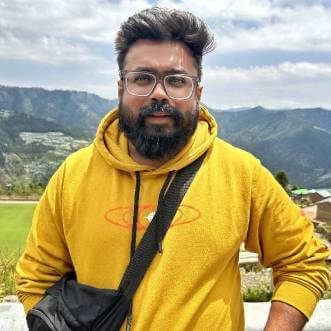Listen on :
Our Guest

Rahul Chatterjee
Product Manager, Vahak
Our Host

Alpi Mantry
Chief Human, Translate By Humans
Our guest in this tale is Rahul Chatterjee, the product manager at Vahak, one of India’s largest online transport communities, trusted by over 20 Lakh Pan-India transporters.
Join us in this podcast as our CEO, Alpi explores the challenges that Rahul masterfully navigates while collaborating with vendors and learning about the pivotal role of the source text in the localisation process. From conquering linguistic frontiers to embracing AI’s evolution, Rahul’s wisdom illuminates the path ahead. Let’s start!
Key Takeaways:
Key Insights:
Welcome to the show, Rahul. Could you tell us about your role at Vahak and your localisation journey so far?
I unexpectedly found my calling in localisation when I joined Vahak as a localisation manager. It shifted from my comfort zone of Western, African, and European markets to the diverse and intricate Indian market. Navigating this vast market, divided by culture and language every few kilometres, felt like managing multiple countries within one.
Vahak’s products are spread across nine regions in India, each with its language, and cater for the niche logistics sector. In a realm where people treasure their native languages, generic templates wouldn’t suffice – precise localisation was imperative. This extended beyond translation to strategic timing; promotions aligned with local festivals like Durga Puja in West Bengal and Lohri in Punjab.
Our dedication to localisation was visible on our page, where campaigns embraced regional aesthetics and characters. The meticulous detailing showcased our commitment. In India, language affinity translated to adaptability; products in native languages held an advantage, making penetration smoother.
My journey into localisation was serendipitous. Starting as a project coordinator, I believed localisation was just translation, questioning its necessity with automated tools like Google Translate. However, immersing in a bustling office and collaborating across teams shattered my misconception. I began with the art of subtitling for global media giants like HBO, Fox, and Disney. I was fascinated by the intricacies of subtitling workflows, diverse file formats, and various teams.
This unexpected journey became a cherished part of my life, transforming my perspective and leading me to where I am today. It’s been a rewarding voyage.
So, what keeps you hooked on this localisation industry? What fascinates you about languages?
It’s about the human connection. Viewing Asians as a bridge to culture and others creates a vital link, especially in localisation. The ever-changing market, with the rise of machine translations, adds to the delightful chaos. For instance, my experience launching a well-received series in 25-26 countries. This connected me with translators from various regions. Now, we exchange holiday wishes—Easter to Diwali—forging unique bonds. Meeting them isn’t necessary; our connection is extraordinary. Words can’t capture the significance and beauty of this journey.
Rahul, I completely agree with you because, you know, languages and cultures are the key differences across the globe. Still, they are also the ones that help us connect with different people at different levels. That is so very well said.
Given your extensive experience with numerous localisation projects and considering the journey you've described, what is your approach when tackling a new localisation project? How do you initiate the process, navigate through it, and determine when it has reached a point of success?
Certainly! The project journey begins with thorough Project Planning. This involves defining the project scope, managing resources, and outlining the workflow details. The workflow addresses factors like the number of QA rounds needed and the possibility of combining machine translation with proofreading to save time.
Once the workflow is set, you decide whether to use in-house translators or find an external vendor based on available resources. Vendor selection is a crucial step.
Following this, another round of QA ensures quality. Effective communication and collaboration are key, ensuring stakeholders are informed about file quality at each step while version control maintains clarity.
Finally, the process concludes with delivery and optimisation, completing the project’s journey.
In your experience collaborating with various vendors and translators across projects, what obstacles arise during the selection process? How do you ensure effective communication to achieve your project's goals? Could you outline the criteria you consider vital for vendor selection success?
Understanding a translator’s background is essential; even with agency-hired translators, I ask for their resumes. But the heart of success lies in conveying the project’s context. Each vendor has project managers experienced in this. Half the battle is won if I can ensure they grasp the context. At the same time, translators are skilled, without contextual comprehensions, like in Vahak, where transport terms and methods matter, precise communication is vital. If vendors lack marketing understanding, the localisation suffers.
Contextual communication is the true secret.
Okay, fair enough.
As you mentioned, when collaborating with vendors and managing communication and teams for translations, how significant is the role of the source text? Do you need to review the source text before starting the localisation process?
Project planning starts with a vital step: meticulously comprehending the source material. Just as I engage with vendors and the Project Manager, this communication approach also holds for interactions with clients. Delving into the source text at its core becomes imperative when dealing with my product. This all unfolds in the project planning phase itself.
In your role in product development, do you encounter difficulties when conveying the significance of localisation to your developers?
Absolutely! It’s a common misconception that localisation is just basic translation, but it’s so much more. Imagine your product as a bird – to make it soar in different places, and it needs adaptable wings. That’s what localisation does: it gives your product wings to fly across diverse markets. So, next time you chat with friends or colleagues, sit with them patiently and take five minutes to share the magic of localisation. It’s not just about words; it’s about making your product truly take flight!
That is good advice because localisation is not translation.
Can we discuss one of the most enriching projects in your localisation journey?
Absolutely! I’ve had the fantastic opportunity to work with HBO, including on Game of Thrones and Succession for two seasons. Being part of that company transformed my perspective on localisation. It wasn’t just about learning tools but about embracing patience, handling multiple tasks, and safeguarding sensitive information. The wild ride taught me both about localisation and valuable life lessons.
Working on Game of Thrones is a feather in your cap. Maybe someday, I will just organise a session to understand that journey in detail. That will be fantastic. So thank you!
Speaking of your experience, you've likely engaged with various technologies in your role, especially in product management and localisation. Can you highlight the key tools, techniques, and technologies you've found essential in your projects?
Of course, in our work, we utilise translation management systems, cloud-based platforms, machine translation, and even terminology lists. But one technology that excites me is the new wave of cloud tools for on-the-go software localisation. As you translate a website from English to Hindi, the platform dynamically updates the site in real-time. It’s like watching your translation come to life instantly. This kind of innovation has been a game changer for me – timely and effective localisation at its finest!
Sure thing! We discussed the advantages of technology. Have you encountered any drawbacks to its use?
Embracing technology for translations has its drawbacks. While machines struggle with context like humans, traditional methods with bilingual documents seem more effective. Cloud tools help with repetitive words, but the personal touch of trained human translators remains valued. Also, tech tools become outdated, risking leaks and confidentiality problems. So, challenges persist in finding the right balance.
Fair enough.
With the rise of AI-driven translations like GPT and chatbots, what do you predict for the future of human translation in a landscape filled with such evolving tools?
Embrace AI, don’t avoid it. Today’s work builds tomorrow’s success. Join forces with AI; the gap only widens if you don’t. Human translation services remains vital in many areas, likely for decades.
Because if you don’t work with it today, you’ll miss out a lot. The gap will keep increasing tomorrow, and you’ll miss the train someday. So, my idea is to work with it and make the most out of it.
As I said, I don't think human intervention within localisation will ever end, at least not in the next 20 years. Thirty years, probably, as well, I see.
Don’t buy into total AI reliance. Instead, blend human-AI strengths. Even in ever-human domains, AI partnership shines. Efficiency and savings await a smart business move.
Definitely, yeah, it makes sense. So, now let's go to the customer support that Vahak provides; given that you're dealing with product management, you guys offer multilingual customer support.
Yes, we do that.
Okay. Is that through a tool? Or do you do it like translations, AI translations?
Our chat support is available in a select few languages, not across multiple languages. However, we have a team of native speakers proficient in various languages who handle things uniquely. While we use a tool for call-related purposes, such as recording and documentation, we haven’t integrated localisation into our process. Our customer support team comprises multilingual individuals with native speakers from different regions. That’s the essence of what we’re all about.
Okay. So, Rahul, what advice would you give to a younger product manager starting in the localisation industry?
One major piece of advice would be to embrace connections and engage in extensive networking throughout various stages of life. Networking acts as a gateway to unforeseen opportunities, unlocking doors beyond imagination.
So one advice would be to talk to people who don’t have any constraints or restrictions in their mind while having this networking; they should be open to everything: different cultures, different languages, different ideologies, different perspectives, for that matter. Never have any constraints in your head.
Second, don’t label anyone unfit for you or any aspect. Go out there and have a good time with everyone you’ll talk with. These are the two major things I will say. And then, lastly, I ensure my younger self understands localisation.
Anything for our viewers, the localisation colleagues, who would be listening to this podcast?
If you haven't implemented localisation yet, consider it because you can increase your business by 60%.
That's a perfect number to look at. Thank you so much for all these insightful answers. It's been great.
We appreciate all the advice and insights you gave us in your journey. And I'm sure we will all be able to learn a lot from it. Thank you so much for your time, and let's keep in touch.
Ladies and gentlemen, this was Rahul Chatterjee orchestrating transformations in the Indian logistics arena. Rahul sheds light on technology integration, will AI replace translators, and the future of human translation in this evolving landscape.
As we part, remember that your content’s journey to global triumph starts with translation and localisation. Take that leap with Translate By Humans, where we don’t just translate – we transform. Embark on this exhilarating ride towards international excellence – book your complimentary call today!